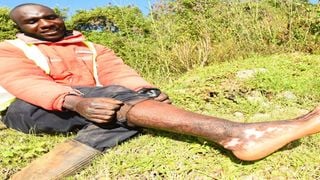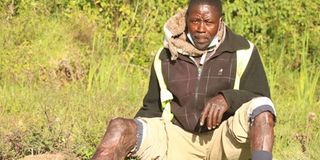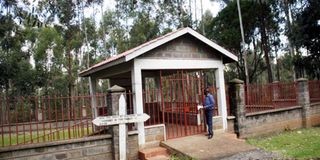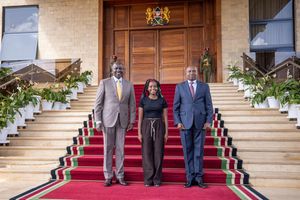
Daniel Wekesa shows the scars from the Sachang’wan oil tanker fire tragedy which happened in 2009.
| Cheboite Kigen | Nation Media GroupNakuru
Premium
Scars a stark reminder of the horror of Sachang’wan, 11 years on
They buried their loved ones a long time ago, their wounds healed, and now, they do casual jobs, including bodabodas, to make ends meet.
A journey on the Nakuru-Eldoret highway and the scars they bear constantly evoke memories of the Sachang’wan oil tanker fire tragedy, 11 years later.
Some of the survivors prefer not to talk about it. Some admit they lost hope of their lives ever returning to normal.
The burn scars on various parts of their bodies are a stark reminder of the nightmarish evening of January 31, 2009.
Mr Daniel Wekesa vividly remembers when the huge ball of fire engulfed him and other residents as he watched people scoop up fuel from an oil tanker that had overturned at Sachang’wan.
Slightly more than a decade later, Mr Wekesa still regrets the terrible decision he made to rush to the scene.
Eager to see
“I was coming from the farm, not far from where the accident happened. I saw people running in excitement towards the road and I was eager to see what had happened. Some had jerry cans, while others hurriedly rode on motorcycles towards the scene,” he recalls.
With a hoe on his shoulder, Mr Wekesa arrived to find dozens of people already siphoning oil from the tanker.
“I was tired and there was little I could do. I watched the drama from a distance and engaged in a conversation with other onlookers. I did not know that standing there would change my life. It was horrible,” he adds.
The tanker was spilling its highly flammable contents and barely an hour later, it burst into flames, injuring anyone near the scene as more than a hundred others were burnt to a crisp.

Mark Njuguna Maina, a survivor of the 2009 Sachang’wan oil tanker fire tragedy.
Burst into flames
Witnesses say the fire was caused by a man who approached the scene while smoking, leading the tanker to burst into flames at about 7pm. The ferocious flames aggressively followed the trail of spilt fuel to neighbouring homes and the forest where the loot was stashed.
“I saw people dying. Anyone who ran away from the scene was burned. Trees, vehicles and nearby homes caught fire. People were running with fire on their clothes and bodies, myself included. Screams could be heard as people called for help but it was too late,” he narrates.
The victims say it was not their wish to scramble for free fuel, but they were pushed by poverty and hunger.
Mr Mark Njuguna Maina recalls the disaster with pain, regret and sadness.
Wounds still fester on his legs, which leak fluid and blood whenever he gets too warm. The bodaboda rider on the Kibunja-Molo-Sachang’wan road said: “I was burnt from the lower abdomen down to my legs. How the trousers I wore that day got off my body is still a mystery. I was left with half of my underwear and every part of my body felt numb. I lost consciousness,” he says.
He was caught by the fire near the tanker’s main channel that spilled out petrol.

The Sachang'wan tanker fire tragedy mausoleum on Nakuru-Eldoret Highway.
Siphoning oil
“I lived in Kibunja then, and I had gone to the scene from my house. I was broke and when I saw people siphoning oil, I joined in. My aim was to scoop and transport as many jerry cans of petrol as possible so that I would sell later and get some money,” he says.
Mr Maina was in various hospital for nine months as he sought treatment in Nakuru. The government waived his bill of Sh1.3 million.
It was Kenya's worst tanker fire tragedy, a testament to the poverty that drives people to risk their lives to steal a potentially deadly substance.
The tanker overturned at a notorious black spot, the site of road crashes over many years.
The national government has since widened the road and increased markings and signage to ensure drivers are more careful.
Redesign road
The Mau Summit junction and Ngata now have a dual carriageway. There are also plans for the road to be redesigned to separate trucks from small vehicles to save more lives.
And while survivors cover their scars with clothing, the psychological wounds have not healed.
Parents lost their children, wives lost their husbands and children lost their parents.
Ms Sarah Tuigong is childless, after her only two sons died in the fire.
“My heart is empty and I’m yet to get back my sleep. I’m so terrified and many times I try as much as possible to avoid passing near that area,” she says.
Ms Jane Wairimu lost her husband and two children in the fire.
“They are all gone and nothing will ever bring them back to me. It has been more than 10 years but I still can’t get them off my mind. I do not know how I will ever heal,” says the elderly Wairimu.
The survivors and those who lost loved ones in the fire say they have been promised financial support by many political leaders but none of them has ever honoured them.

President Mwai Kibaki (centre) and other leaders during the burial service for Sachang'wan fire victims in 2009.
Victims neglected
Nominated MCA Rachel Maru says victims have been neglected and no effort has been made to turn the pain of the accident into something good
Apart from Sh50,000 the Kibaki-Raila government gave to some of the victims’ families, there has been no compensation, she says.
"I have personally struggled to lobby for a trauma centre to be established here as a way of memorialising the accident, to no avail," says Mr Maru, adding, "After all these years, it is clear that no one cares any more."
Majority of the youths from Sachang’wan, Kibunja, Molo and nearby areas were preteens and teens at the time, and they too bear the scars.
Some are disfigured and face discrimination when they look for jobs. Others cannot be in the scorching sun for long, limiting their job options.





